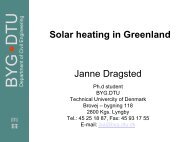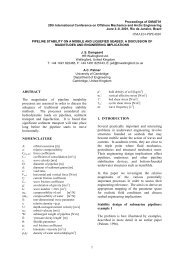Cantilever-like micromechanical sensors - Artek
Cantilever-like micromechanical sensors - Artek
Cantilever-like micromechanical sensors - Artek
Create successful ePaper yourself
Turn your PDF publications into a flip-book with our unique Google optimized e-Paper software.
Rep. Prog. Phys. 74 (2011) 036101 A Boisen et al<br />
Figure 1. Schematic of three modes of operation of a cantilever-based sensor. The cantilever is seen from the side. Molecules on one side of<br />
the cantilever cause a change in surface stress which causes the cantilever to deflect (a). Bulk stress changes in the cantilever material can be<br />
used to detect temperature changes caused by a chemical reaction (b). Mass changes are registered by measuring changes in the resonant<br />
frequency of the cantilever (c).<br />
has been interacting with the surface. If an added molecular<br />
layer, for example, contracts compared with the underlying<br />
material, the cantilever will bend towards the molecular<br />
layer. This measuring principle has been used to detect, for<br />
example, prostate-specific antigen (PSA) [22] and to study<br />
antibiotics binding to drug resistant super bugs [23]. A<br />
related technique to study surface stress changes is called<br />
the bending plate technique and was first observed and<br />
applied on wafers of III–V compounds in the 1960s [24].<br />
By introducing the cantilever technique this measurement<br />
principle was significantly improved. Using the bending plate<br />
technique surface stress changes of 1 N m −1 were normally<br />
reported whereas the first measurements of surface stress<br />
changes with micrometre-sized cantilevers were of the order<br />
of 10 −3 Nm −1 . Now, surface stress changes of 10 −6 Nm −1<br />
are routinely observed.<br />
In a second mode of operation the cantilever is used<br />
as a tool to evaluate stress changes in the bulk of the<br />
cantilever material, for example, caused by humidity or<br />
temperature. Stress changes are explored in the realization<br />
of extremely sensitive thermometers. <strong>Cantilever</strong>s consisting<br />
of two materials with different thermal expansion coefficients<br />
will bend as a function of temperature due to the bimorph effect.<br />
This effect can be used to measure temperature changes down<br />
to 10 −5 K and can, for example, be used to investigate phase<br />
changes in minute amounts of sample [25] (figure 1(b)).<br />
In a third mode of operation the fact that the resonant<br />
frequency of the cantilever depends on the mass of the<br />
cantilever and the resonant frequency drops as the mass<br />
increases is used. Thus, it is possible to make indirect mass<br />
change estimations in the atto- to zepto-gram range [26] by<br />
following the resonant frequency change of the cantilever<br />
(figure 1(c)).<br />
The change in static cantilever deflection or change in<br />
vibrational amplitude is most commonly detected by the<br />
so-called optical leverage technique which is well known from<br />
AFM. The principle will be described in section 4 and basically<br />
a laser is reflected off the backside of the cantilever and onto a<br />
position sensitive diode.<br />
In nearly all experiments performed today a reference<br />
measurement is included. This means that a second cantilever<br />
with identical mechanical performance but without the specific<br />
surface funtionalization is monitored simultaneously. Often<br />
only the differential signals are presented since the use of<br />
reference measurements significantly reduces drift and noise<br />
from, for example, temperature and humidity changes.<br />
3<br />
2.1. Detection of mass changes<br />
In mass sensing, cantilever and bridge shaped geometries<br />
are both commonly used and are in general referred to<br />
as beam-based mass <strong>sensors</strong>. Both geometries will be<br />
introduced in the following. A cantilever is a singly clamped<br />
beam whereas a bridge is a doubly clamped beam. One<br />
of the ultimate goals of a beam-based mass sensor is the<br />
ability to measure single small molecules which requires<br />
a sensitivity in the sub-zepto-gram (10 −21 g) regime. This<br />
would, for example, make it possible to use a cantilever as a<br />
mass-spectrometer with sensitivity better than commercially<br />
available systems of today. The sensitivity or minimum<br />
detectable mass depends on the ratio between the mass<br />
and the resonant frequency of the beam. Generally, the<br />
resonant frequency increases and the mass decreases when the<br />
dimensions are decreased. Thus, a straightforward approach<br />
to enhance the sensitivity is to decrease the dimensions of the<br />
beam. The feature size of beam-based mass <strong>sensors</strong> is currently<br />
approaching the nanometre scale. Recently, systems capable<br />
of detecting masses in the atto- and zepto-gram (10 −18 –<br />
10 −21 g) range have been reported [27, 28], and the claim<br />
is that yocto-gram sensitivity is within reach [29]. This is<br />
far better than the reported mass sensitivities of other mass<br />
sensing techniques, such as the quartz crystal microbalance<br />
technique where typical sensitivities are in the nano/picogram<br />
range [30] for a single device. Sensors with a larger<br />
surface area generally have a relatively large distributed mass<br />
resolution (mass resolution per area). For example, socalled<br />
bulk disc resonators with micrometre dimensions now<br />
have similar distributed mass resolution as nanometre-sized<br />
cantilever resonators [31]. As a consequence, nanometresized<br />
resonators are useful when striving to achieve ultrahigh<br />
point mass resolution. In terms of distributed mass<br />
resolution the benefit of miniaturization is less pronounced.<br />
Here, for example, micrometre [32] and nanometre-sized [33]<br />
cantilevers have been reported to have similar distributed mass<br />
sensitivities.<br />
To explain the working principle of a beam-based mass<br />
sensor we will in the following introduce the equations<br />
describing the motion of a beam. Also, the importance of<br />
damping and Q-factor will be introduced.<br />
2.1.1. The eigenfrequency of bending beams. For a thin beam<br />
as depicted in figure 2, rotational inertia and shear deformation<br />
can be neglected. Assuming a linear elastic material and small





